 Driving a
Driving a
Low Emissions
Economy
How local authorities can support
and promote electric vehicles
 Driving a Low Emissions Economy
Driving a Low Emissions Economy – A Guide to Supporting and Promoting Electric Vehicles in Our Communities
2
This guide aims to help local authorities reduce emissions by making their
communities more friendly to electric vehicles (EVs).
It summarises the environmental, social and economic case for EVs, provides
advice on operational and long-term planning, and outlines practical steps
councils can take to help New Zealand transition to a low emissions economy.
It is produced by the Energy Efficiency and Conservation Authority (EECA)
as part of the Government’s information campaign to accelerate the uptake of
EVs in New Zealand.
 Driving a Low Emissions Economy
Driving a Low Emissions Economy – A Guide to Supporting and Promoting Electric Vehicles in Our Communities
3
An
In 2017, Mayors and Chairs of 52 councils
around New Zealand committed to developing
environment
and implementing ambitious action plans to
reduce greenhouse gas emissions and support
resilience within their own organisations and
for change
local communities1.
These plans include supporting the use of
renewable energy and uptake of electric vehicles
(EVs), walking, cycling, public transport and
other low carbon transport options.
This commitment to promote positive change
within communities sits alongside the statutory
obligations placed on local authorities to:
• meet the current and future needs of their
communities, including infrastructure that is
efficient, effective and future focused2, and
• promote the sustainable management
of natural and physical resources3.
1.
www.lgnz.co.nz/assets/Uploads/Climate-Change-
Declaration-updated-17-November-2017.pdf
2. Local Government Act 2002
3. Resource Management Act 1991
Driving a Low Emissions Economy – A Guide to Supporting and Promoting Electric Vehicles in Our Communities
4
The
Government Policy Statement on Land
What is an EV?
Transport (‘GPS’)4 outlines the Government’s
strategy to guide land transport investment
Battery EVs (BEVs) and plug-in hybrid EVs
and resource allocation over the next ten years
(PHEVs) are the two main types of electric
to ensure the transport network can meet the
vehicle. Both have electric motors and batteries
country’s future needs. One objective is to
that are charged from an external power supply,
create a land transport system that “increasingly
but there are some key differences between
mitigates the effects of land transport on the
them:
environment” which includes reduced CO2
emissions.
• A BEV is powered solely by the battery,
which is charged by plugging into an electrical
power point. Regenerative braking also charges
the battery during driving (for example, when
driving downhill). A BEV has no tailpipe.
EECA measures greenhouse
• PHEVs have an electric motor and battery that
gas emissions by tonnes of
is charged from an external power supply, and
carbon dioxide equivalent
an internal combustion engine fueled by petrol
(tCO e) – also referred to
2
or diesel. Regenerative braking also charges
as CO or ‘carbon emissions’.
2
the battery during driving - either in EV-only
mode or when the petrol or diesel engine is
A car produces 1 tonne of
used. Most PHEVs drive in EV-only mode for a
greenhouse gas emissions
certain distance until most of the power stored
from using 424 litres of
in the battery is used, then the engine takes
petrol or driving (on average)
over automatically. During heavy acceleration,
4,400 kilometres.
such as driving fast up a steep hill, both the
petrol or diesel engine and the electric motor
The average NZ car
work together to avoid excessive draw from the
emits about 2.6 tonnes
battery.
of greenhouse gas per year.
Hybrids which can’t plug in are not EVs,
although they tend to be more fuel efficient than
a comparable petrol car. Their only source of
EVs offer one of New Zealand’s biggest
energy is the fuel used by the engine, although
opportunities to reduce CO
the battery is charged by the combustion
2 emissions and
increase the uptake of renewable energy.
engine, and energy is captured when the vehicle
Supporting the adoption and use of EVs is one
brakes (regenerative braking).
of the ways local authorities can look to comply
with their GPS commitments.
Government agencies are working closely
together to enable infrastructure and improve
EV supply, demand, feasibility, awareness and
ultimately uptake.
So how can local government influence
EV ownership and use as a means of
reducing greenhouse gas emissions?
4.
https://www.transport.govt.nz/multi-modal/
keystrategiesandplans/gpsonlandtransportfunding/
 Driving a Low Emissions Economy
Driving a Low Emissions Economy – A Guide to Supporting and Promoting Electric Vehicles in Our Communities
5
What makes
Light vehicles accounted for 67% of
New Zealand’s transport greenhouse gas
EVs the
emissions in 2015, making EVs one of our
biggest opportunities to significantly reduce
greenhouse gas emissions.
right choice?
Read more about the Government’s
Like many nations, New Zealand
EV programme at
needs to take bold action to achieve
www.transport.govt.nz/ev
its Paris Agreement commitment to
reduce greenhouse gas emissions to
30% below 2005 levels by 2030.
The Government is committed to doubling the
number of EVs on New Zealand roads every year
until 2021, at which point they will represent 2%
of the country’s total light vehicle fleet. Measures
to help achieve this include road user charge
exemptions, and co-funding for EV projects.
The good news is the number of EVs on
New Zealand roads has grown rapidly in recent
years, spurred on by improvements in both the
cost-effectiveness and range of EVs, and the
availability of public charging infrastructure up
and down the country. New EV registrations5
indicate that we are well on track to achieve the
Government’s 2021 target.
5.
https://www.transport.govt.nz/resources/vehicle-fleet-
statistics/monthly-electric-and-hybrid-light-vehicle-
registrations/
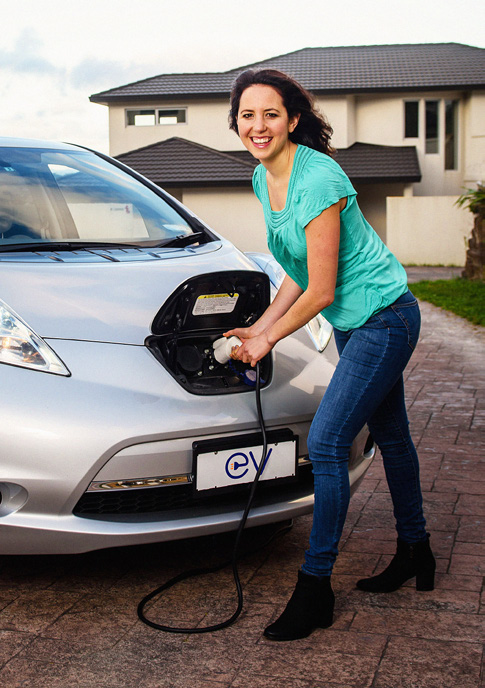 Driving a Low Emissions Economy
Driving a Low Emissions Economy – A Guide to Supporting and Promoting Electric Vehicles in Our Communities
6
There are a number of reasons why New Zealand
Economic benefits
is well placed to capture a significant amount of
the benefits that EVs offer6, including:
•
Increased tourism: Having charging stations
sited at handy locations such as museums,
• 85% of New Zealand’s electricity is generated
cafés and local attractions can increase visitor
from renewable sources (unlike many other
numbers by attracting EV drivers to the
countries)
district who will spend money locally while
their vehicle is charging7.
• there are sufficient consented renewable
generation projects for New Zealand to
•
Return on investment: New EVs may be more
recharge all our 3.6 million light vehicles
expensive up front in terms of initial purchase
if they were replaced with EVs
costs, but the lower average running costs
combined with lower maintenance costs over
• 85% of New Zealand homes have off-street
the lifetime of the vehicle balances out and in
parking, meaning EVs can be easily charged
some cases offsets the higher upfront cost.
overnight at home, and
For instance, you can save up to 85% on fuel
• New Zealand’s 230-volt electricity system
costs by charging your EV overnight.
means every home has the potential to
OVERNIGHT
charge an EV.
CHARGE
up to
UIVALENT TO PAYING
$3
What specific benefits do EVs offer to councils
EQ 30c
per
and the communities they serve?
per litre
100km
Benefits can be categorised as economic,
environmental and social.
Used EVs can compare well with
conventional imports and are
available with very low odometer
readings, offering fleet operators
an alternative vehicle choice. Some
used vehicle dealers offer warranties
on the propulsion batteries.
•
Investment Partnerships: Creating
infrastructure partnerships to share costs (e.g.
with energy companies, trusts or ChargeNet
NZ) and/or applying for other sources of
funding (e.g. the Low Emission Vehicles
Contestable Fund, and MBIE’s Tourism
Infrastructure Fund) can make the investment
in EV infrastructure relatively low cost/low risk
while creating a visible statement of
council’s commitment.
6.
www.transport.govt.nz/assets/Uploads/Our-Work/
Documents/Factsheet-Why-Electric-Vehicles-are-well-
suited-for-NZ.pdf
7. Statistics for the Upper Hutt City CBD fast charging station
show 66% of users live outside Upper Hutt City
Driving a Low Emissions Economy – A Guide to Supporting and Promoting Electric Vehicles in Our Communities
7
Environmental benefits
Social benefits
•
Reduced greenhouse gas emissions: Driving
•
Supporting regional development: Less
an EV can reduce CO2 emissions by around
money spent on imported oil by consumers
80%, because most of the electricity used to
means more money spent on electricity
charge an EV is generated from renewable
generated and distributed domestically
energy sources (85% in 2016), unlike the fossil
including by local lines companies.
fuels that drive our traditional transport fleets.
•
Meeting statutory obligations and
•
Fewer lifecycle emissions: Even once
demonstrating leadership: Promoting the
raw material extraction, battery and vehicle
uptake of EVs aligns with local authority
manufacture and shipping are taken into
statutory responsibilities, and offers a tangible
account, EVs emit 60% fewer greenhouse
leadership role in raising awareness and
gas emissions over their full lifecycle than
demonstrating low carbon leadership.
petrol vehicles.8
•
Supporting community EV uptake: EVs
•
Pollution-free driving: Pure EVs
entering council and other fleets today will
(those 100% powered by electric batteries)
provide a source of cheaper second-hand
don’t have a tailpipe so, as well as not
EVs accessible to local families and small
producing greenhouse gases, they produce
businesses in the future.
no harmful exhaust emissions that cause
local air pollution. Improved air quality
means less respiratory illnesses and fewer
hospital admissions.
•
Noise reduction: Noise pollution is
detrimental to human health, being linked
to a range of health issues including heart
disease and hearing loss. Not only is engine
Calculating the
noise an issue for the occupants of vehicles,
Total Cost of Ownership
it’s also a problem for the residents of towns
and cities. EVs are quieter than petrol or
Choosing the right vehicle for your fleet
diesel vehicles, making them an attractive
comes down to more than just purchase
option for communities.
price. Looking at the total cost of ownership
could make a big difference to your bottom
line and your carbon footprint.
80%
TAILPIPE EMISSION
O
S
fewer
N
EECA’s total cost of ownership tool9 (TCO)
makes it easy for you to compare the cost
CO2
emissions
of buying, running and on-selling new
than a petrol
vehicles, whether they are electric, hybrid,
vehicle when
used in NZ
petrol or diesel, and helps you decide
which one is right for you.
60%
fewer
CO2
emissions
across the lifecycle
8.
www.eeca.govt.nz/assets/Resources-EECA/ev-lca-final-
of the vehicle
report-nov-2015
9.
www.eecabusiness.govt.nz/tools/vehicle-total-cost-of-
ownership-tool
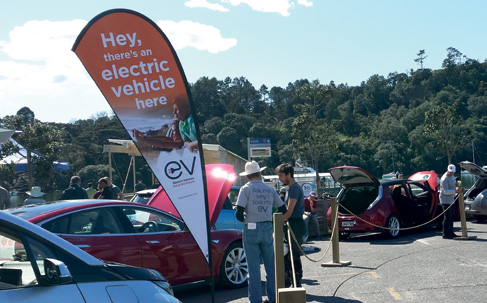 Driving a Low Emissions Economy
Driving a Low Emissions Economy – A Guide to Supporting and Promoting Electric Vehicles in Our Communities
8
Driving
1. Incorporate climate action
in long term planning
EV uptake
The best place to start is to consider how
New Zealand’s EV growth will be planned for
in your community.
Encouraging the transition to
Long term plans and annual plans provide an
EVs is one way local authorities
opportunity to consider how EVs can support
can begin to target a reduction
goals regarding the environment, air quality, and
in greenhouse gas emissions and
economic development. There is also value in
support resilience within their
aligning goals and activities to broader timeframes,
such as the Government’s 2021 EV goal, our Paris
own organisations and local
Agreement target to reduce emissions to 30%
communities.
below 2005 levels by 2030, and the Government
Policy Standard on Land Transport.
The following section outlines a range of
policies and other activities which could
Some councils have included EVs into their
be adopted by local authorities to help
planning processes already, such as Wellington
support the uptake of EVs by councils,
City Council’s Low Carbon Capital Plan10.
business and the wider community.
2. Raise awareness
A number of things can be done to raise
awareness and understanding of EVs both within
council and across the local community.
One of the best ways to encourage EV uptake
within your organisation is to give staff the
opportunity to experience driving an EV for
themselves; arrange EV test drives from registered
EV dealers or direct from the manufacturer11,
and/or gain approval to trial an EV in your fleet.
10.
https://wellington.govt.nz/your-council/plans-policies-and-
bylaws/policies/low-carbon-capital-plan-(2016)
11.
www.driveelectric.org.nz/individuals/ev-models-and-
where-to-buy
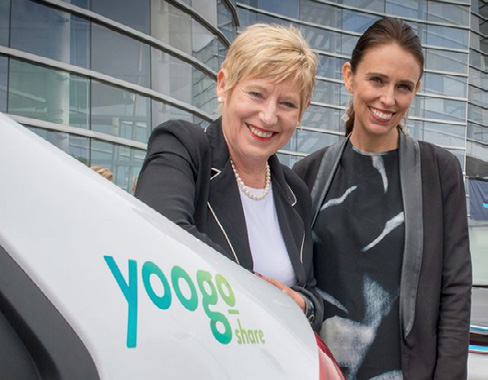 Driving a Low Emissions Economy
Driving a Low Emissions Economy – A Guide to Supporting and Promoting Electric Vehicles in Our Communities
9
When developing a business case for transitioning
to EVs in your organisation, talk to fleet
optimisation service providers and/or vehicle
Case Study:
Yoogo -
dealers to research the opportunities EVs present
Electrifying Christchurch
(including the option of leasing versus purchasing),
and to better understand the technical aspects of
operating and maintaining an EV. A good place to
Source: www.yoogoshare.co.nz
start is
www.electricvehicles.govt.nz
Finally, be sure to publicise and celebrate
progress the council and community makes
around EVs. For example, bring EVs to community
events and let the cars, and their enthusiastic
owners, do the talking.
3. Undertake a fleet audit
and identify optimisation
opportunities
As well as the more traditional direct ownership
model, other business models for vehicle
On 15 February 2018, Prime Minister
management are now available to organisations,
Jacinda Ardern officially launched
such as fleet leases and electric car share schemes.
Christchurch’s first 100% EV sharing service,
a scheme the Christchurch City Council
Consider a fleet audit to see where you could
hopes will drive transformational change
make cost and emissions savings. A fleet audit will
in terms of carbon emissions, and attitudes
help you to identify whether your current fleet is fit
about future vehicle ownership.
for purpose and understand which vehicles could
be replaced with EVs, and in what role(s).
The scheme provides businesses and
the public with access to a pool of 100
Installing telematics in your vehicle fleet will enable
EVs from hubs around the city, making
your organisation to better understand how your
it the largest scheme of its type in the
vehicles are being used. Telematics allow you to
southern hemisphere.
record travel information such as distance and
time travelled, the routes being driven, driving
Led by the Christchurch City Council in
speeds, right down to how quickly a driver is
partnership with Yoogo, the initiative
braking. This information is perfect in helping
received funding from round two of the Low
an organisation to optimise fleet efficiency and
Emission Vehicles Contestable Fund and the
identify ideal EV substitutions.
Christchurch Agency for Energy Trust.
The scheme’s foundation partners included:
Ara Institute, Aurecon, Beca, Canterbury
District Health Board, Chapman Tripp,
Christchurch City Council, Environment
Canterbury, Meridian Energy, Tonkin and
Taylor, Warren and Mahoney, Christchurch
International Airport and Jacobs.
Learn more about Yoogo’s EV sharing
scheme at:
www.yoogoshare.co.nz
 Driving a Low Emissions Economy
Driving a Low Emissions Economy – A Guide to Supporting and Promoting Electric Vehicles in Our Communities
10
4. Transition your fleet to EVs
Transitioning your fleet to electric requires a clear
plan and timetable.
A simple place to start is to encourage council
staff to prioritise EVs when hiring cars or
booking taxis, and to support low emissions
service providers, such as for courier deliveries.
As technology develops, heavy vehicles such as
buses, trucks, and other forms of transport will
also begin to switch to electric.
Exposing staff to EVs in this way will make the
transition to an EV fleet easier as they will be
more comfortable with EVs and their performance
in everyday situations. The next step is to make
sure your organisation has a clear policy in place
around the type of vehicles it will consider when
replacing existing vehicles in the fleet.
Source: GWRC electric vehicle policy
Masterton District Council, Whangarei District
Council, Hawke’s Bay Regional Council, and
New Zealand Government Procurement’s EV
Greater Wellington Regional Council12 have all
catalogue provides a list of EVs13. This list will
adopted ‘electric first’ policies into their operations.
continue to grow as new EV models enter the
This means that all fleet vehicles purchased are
New Zealand market14.
ful y electric, unless an EV is not fit for the specific
work purpose. Where a fully electric EV cannot be
A growing number of dealers sell low-mileage
purchased, a plug-in hybrid is the next preference,
used EVs which offer great value. However,
with a conventional vehicle the last resort. Approval
consider safety ratings as some Japanese
for opting out of an EV purchase rests with the
domestic EVs sold as used vehicles in
executive management team.
New Zealand do not have a five star safety
rating, and ask for battery warranties.
EECA provides a cost calculator15,
and agencies and local authorities
wanting to add EVs to their fleet may
be able to apply for funding through
an interest-free Crown loan scheme16.
electric
12.
www.gw.govt.nz/assets/Climate-change/GWRCelectric-
v e h i c l e
vehicle-policy-2016.pdf
13.
www.procurement.govt.nz/contracts/motor-vehicles
14.
www.driveelectric.org.nz/many-more-plugin-vehicle-
models-about-to-reach-new-zealand
15.
https://www.eecabusiness.govt.nz/tools/vehicle-total-cost-
of-ownership-tool/
16.
https://www.eecabusiness.govt.nz/funding-and-support/
crown-loans/
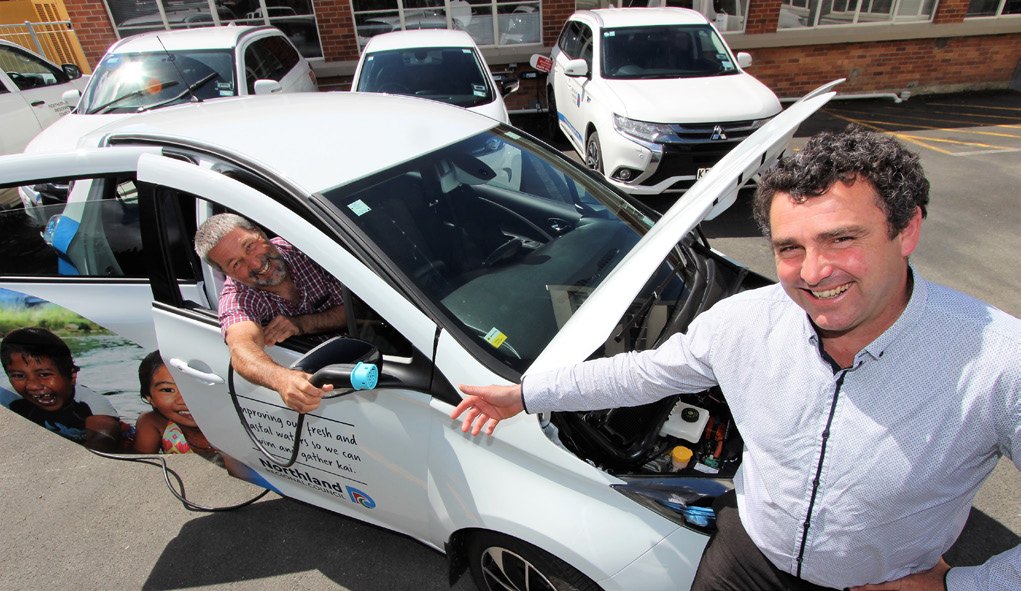 Driving a Low Emissions Economy
Driving a Low Emissions Economy – A Guide to Supporting and Promoting Electric Vehicles in Our Communities
11
Case Study:
Northland Regional Council
In May 2014, Northland became the first
its PHEVs. The council aims to eventually
region in New Zealand to offer EV drivers
convert most of its 60-plus vehicle fleet
access to a fast charging station with the
to EVs.
very first station installed in Whangarei.
The Northland Regional Council (NRC)
NRC’s 20kW solar installation
has also been a keen early adopter of
generates enough power to
EVs. By 2018 it had seven battery electric
drive about 500kms per day,
vehicles (BEVs), three plug-in hybrid
cutting around $26,000 from
electric vehicles (PHEVs), and 80 solar
the council’s annual fuel bill.
panels atop its headquarters to help
charge them.
Councillor Justin Blaikie says the
NRC has also worked in partnership
NRC’s foray into EV ownership has been
with the Far North District Council
driven by the potential long-term financial
and nationwide EV charging provider
savings and environmental benefits.
ChargeNet NZ to install five fast charging
stations across Northland, enabling locals
Its current fleet comprises of a number
and tourists to travel the entire region in an
of different EV models that offer differing
EV. Dubbed ‘Northland’s Crimson Coast EV
range options depending on the purpose
Highway’, the project was supported by
of the vehicle: from 120km-250km per
the Government’s Low Emission Vehicles
charge for its BEVs to over 500km for
Contestable Fund, administered by EECA.
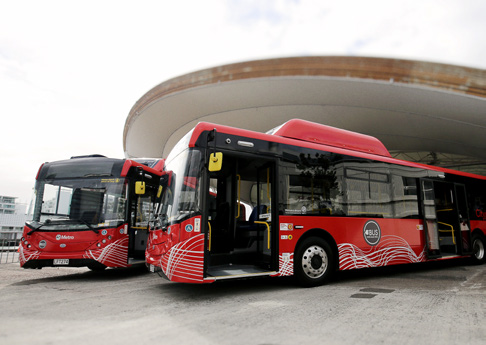 Driving a Low Emissions Economy
Driving a Low Emissions Economy – A Guide to Supporting and Promoting Electric Vehicles in Our Communities
12
5. Support the rollout of public
charging infrastructure
One of the keys to building public (and staff)
confidence in EVs is ensuring there are sufficient
charging facilities available in convenient locations
for both local motorists and visitors to the region.
The Transport Agency’s guidelines on public
charging infrastructure provide excellent advice on
evaluating, siting and installing EV infrastructure17.
Before determining whether a site might be
suitable for public EV charging infrastructure,
it’s important to understand how you expect the
6. Encourage electric buses
charging station to be used. Inexpensive slow
chargers suit long-stay locations; high cost fast-
‘Electric vehicles’ means more than cars – electric
charge stations suit short-stay locations.
buses are ideal for public transport. 100% battery
Ideal locations include highly visible or popular
electric bus technology is well established
destinations (such as cafés, museums and
overseas and has made its debut in New Zealand.
recreation centres). Consider installing charging
Regional and unitary councils are in a unique
facilities in new/upgraded council facilities as a
position to facilitate the uptake of electric buses
standard feature.
by recognising their benefits through their public
Consider partnerships (e.g. with energy companies
transport contracts.
or trusts or ChargeNet NZ) to share costs. Other
Communities benefit when diesel buses are
sources of funding include the Low Emission
replaced with electric because emissions
Vehicles Contestable Fund18 and MBIE’s Tourism
detrimental to air quality and human health
Infrastructure Fund19.
are eliminated. Electric buses are also much
Several councils have undertaken infrastructure
quieter, and as they run on New Zealand’s highly
projects, including street side, car parking
renewable electricity, they contribute to your
buildings, and outside iSites.
community’s efforts to reduce greenhouse gases.
All councils ought to recognise the importance
of charging infrastructure location for electric
17.
http://www.nzta.govt.nz/planning-and-investment/
buses operating in their jurisdiction. To avoid
planning/transport-planning/planning-for-electric-
vehicles/national-guidance-for-public-electric-vehicle-
significant additional costs, it needs to be close
charging-infrastructure/
to local electricity distribution networks with
18.
www.eeca.govt.nz/funding-and-support/low-emission-
enough capacity to meet charging demands.
vehicles-contestable-fund
19.
www.mbie.govt.nz/info-services/sectors-industries/
tourism/tourism-infrastructure-fund
Councils can recognise this in any resource
consent process. It could be critical when
decisions are being made on where to locate
bus depots, roadside opportunity charging
facilities for a specific bus route, and new
or upgraded transformer and electricity
distribution infrastructure.



 Driving a Low Emissions Economy
Driving a Low Emissions Economy – A Guide to Supporting and Promoting Electric Vehicles in Our Communities
13
7. Be EV friendly
Finally, provide directional and positional
signposting22 from highways and main streets to
As a council you can demonstrate your support
highlight the availability of charging facilities to
for EVs by making it easier for EV drivers to travel
both EV owners and non-EV owners, and help
around your district.
overcome range anxiety.
One way to do this is by offering EVs special
access to roadways including special vehicle
lanes - in September 2017 Auckland City Council
and the Transport Agency began a 12 month trial
of such a scheme20.
Councils can also offer
convenient EV-only car
parking and designate
car parking exclusively for
EVs adjacent to charging
infrastructure, using the
The New Zealand Transport Agency recommends
gazetted Electric Vehicle
that approved signage and symbols are used for
Parking Only symbol21.
all public and private parking spaces reserved for
EVs charging their batteries.
8. Introduce regulations for
charging infrastructure
Councils can allow for the future proofing of public
infrastructure, dwellings and municipal buildings.
District Plan rules can specify public charging
infrastructure as a permitted activity and set the
number of charging units required on buildings
and apartments.
20.
www.nzta.govt.nz/media-releases/green-light-for-
auckland-electric-vehicle-bypass-lane-trial
21.
https://www.gazette.govt.nz/notice/id/2017-
au1528?noticeNumber=2017-au1528
22.
http://www.nzta.govt.nz/planning-and-investment/
planning/transport-planning/planning-for-electric-vehicles/
national-guidance-for-public-electric-vehicle-charging-
infrastructure/enabling-the-development-of-public-
charging-infrastructure/advice-for-road-controlling-
authorities/symbols-signs-and-road-markings/
 Driving a Low Emissions Economy
Driving a Low Emissions Economy – A Guide to Supporting and Promoting Electric Vehicles in Our Communities
14
The EV
• EVs are quiet. Reduced noise levels mean
drivers often feel more focused and calm
experience
when driving EVs – an observation backed
up by a recent study of London taxi drivers.
From outside the car, tyre noise can be heard
once they reach about 25km per hour. Some
EVs emit audible sounds at low speeds to
Driving an EV is much the same as
alert pedestrians and cyclists.
a petrol or diesel car – but people
• They’re smooth and peppy: EVs can
often notice a few differences.
accelerate quickly and smoothly from
a standing start. With no gears to work
through, an EV is able to apply full power as
soon as you touch the accelerator pedal. This
means they’re great hill climbers.
• They handle well: The heavy battery packs
fitted to the floor give EVs a lower centre
of gravity, so they usually enjoy superior
handling and are less likely to roll in an
accident.
• The braking is different: The regenerative
braking system means the car starts to
slow as you lift your foot off the accelerator.
Lifting further or fully off the pedal causes
it to slow more sharply (and the brake lights
will come on).
• Safety is designed in: EVs sold in New
Zealand must meet the same minimum
vehicle safety standards as petrol and diesel
vehicles. Their high-voltage electric system
is designed to automatically deactivate in a
crash. They are far less likely to catch fire in
an accident than petrol or diesel vehicles.
• They suit our climate: Battery life can be
reduced by extreme temperatures – below
freezing and above 30 degrees Celsius –
but EVs are well suited to New Zealand’s
temperate climate.
Driving a Low Emissions Economy – A Guide to Supporting and Promoting Electric Vehicles in Our Communities
15
Additional information
and resources
Electric Vehicle Information Website
Setting Up Public Charging Infrastructure
www.electricvehicles.govt.nz
http://www.nzta.govt.nz/planning-and-
investment/planning/transport-planning/
planning-for-electric-vehicles/national-
Frequently Asked Questions about EVs
guidance-for-public-electric-vehicle-charging-
www.leadingthecharge.org.nz/faq
infrastructure/
Suitability of EVs
WorkSafe New Zealand Electric Vehicle
for New Zealand Fact Sheet
Charging Safety Guidelines
www.transport.govt.nz/assets/Uploads/
https://worksafe.govt.nz/laws-and-regulations/
Our-Work/Documents/Factsheet-Why-Electric-
consultations/review-of-the-electric-vehicle-
charging-safety-guidelines/
Vehicles-are-well-suited-for-NZ.pdf
Low Emission Vehicles Contestable Fund
‘Electric First’ example vehicle
www.eeca.govt.nz/low-emission-vehicles-
policy text and electric fleet case study
contestable-fund
www.gw.govt.nz/electric-vehicles
email: [email address]
Electric vehicle events, information
New Zealand Government Procurement
guide, car models and dealer list
www.procurement.govt.nz/contracts/motor-
www.leadingthecharge.org.nz
vehicles/motor-vehicle-suppliers
Drive Electric, not-for-profit
MBIE Tourism Infrastructure Fund
EV advocacy group
www.mbie.govt.nz/info-services/sectors-
www.driveelectric.org.nz
industries/tourism/tourism-infrastructure-fund
EECA EV queries
EECA Interest-Free Crown Loans
email: [EECA request email]
www.eecabusiness.govt.nz/funding-and-
phone: 0800 358 676
support/crown-loans
Public Charging Infrastructure Vision,
Guidance, and Charging Station Maps
www.nzta.govt.nz/electric-vehicles
Driving a Low Emissions Economy – A Guide to Supporting and Promoting Electric Vehicles in Our Communities
16
EEC4263 April 2018














